Impression Management in Daily Life and the Impact of Social Media
VerifiedAdded on 2022/08/18
|9
|1868
|16
Essay
AI Summary
This essay delves into the concept of impression management, examining how individuals consciously or subconsciously control and regulate information to influence the perceptions of others. It explores the definition of impression management, its application in various contexts, and its relation to self-presentation. The essay discusses the role of social media in shaping personal impressions, encouraging a reflection on one's digital footprint and online persona. Furthermore, it touches upon the concept of the 'Looking Glass Self' and the impact of cyberbullying, providing a comprehensive analysis of impression management in contemporary society. The essay highlights the importance of understanding how individuals present themselves and how external factors influence these presentations.
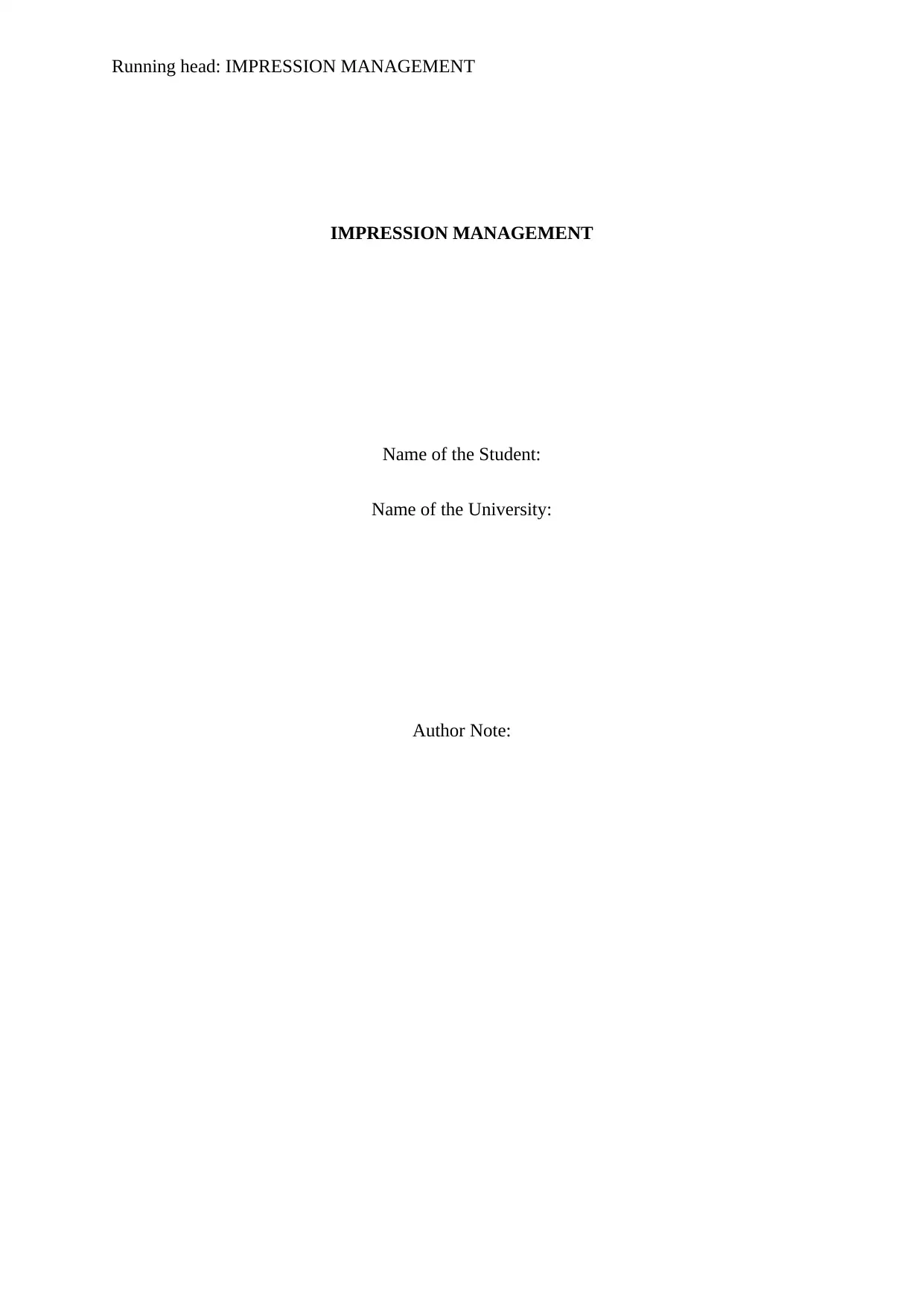
Running head: IMPRESSION MANAGEMENT
IMPRESSION MANAGEMENT
Name of the Student:
Name of the University:
Author Note:
IMPRESSION MANAGEMENT
Name of the Student:
Name of the University:
Author Note:
Paraphrase This Document
Need a fresh take? Get an instant paraphrase of this document with our AI Paraphraser
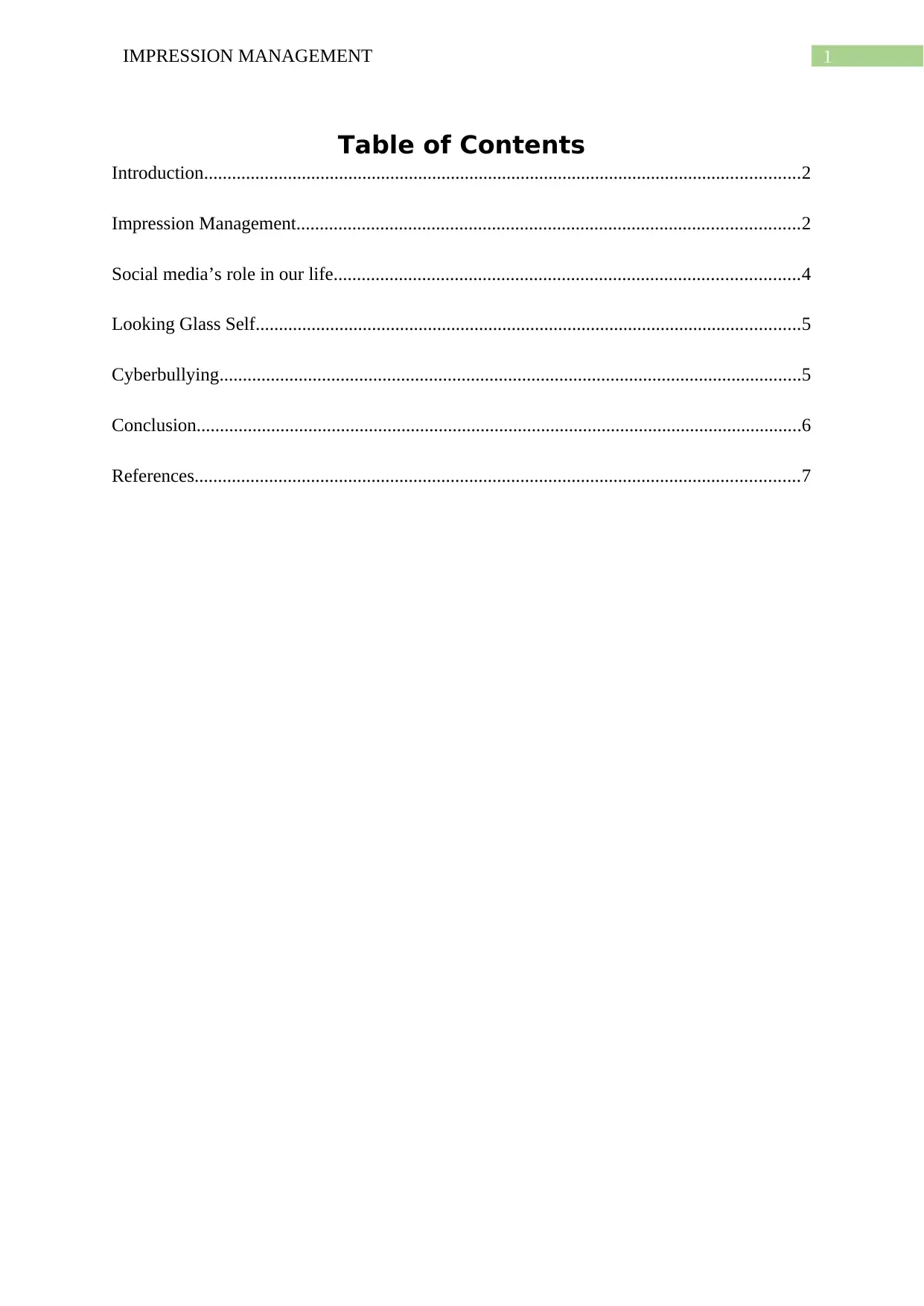
1IMPRESSION MANAGEMENT
Table of Contents
Introduction................................................................................................................................2
Impression Management............................................................................................................2
Social media’s role in our life....................................................................................................4
Looking Glass Self.....................................................................................................................5
Cyberbullying.............................................................................................................................5
Conclusion..................................................................................................................................6
References..................................................................................................................................7
Table of Contents
Introduction................................................................................................................................2
Impression Management............................................................................................................2
Social media’s role in our life....................................................................................................4
Looking Glass Self.....................................................................................................................5
Cyberbullying.............................................................................................................................5
Conclusion..................................................................................................................................6
References..................................................................................................................................7
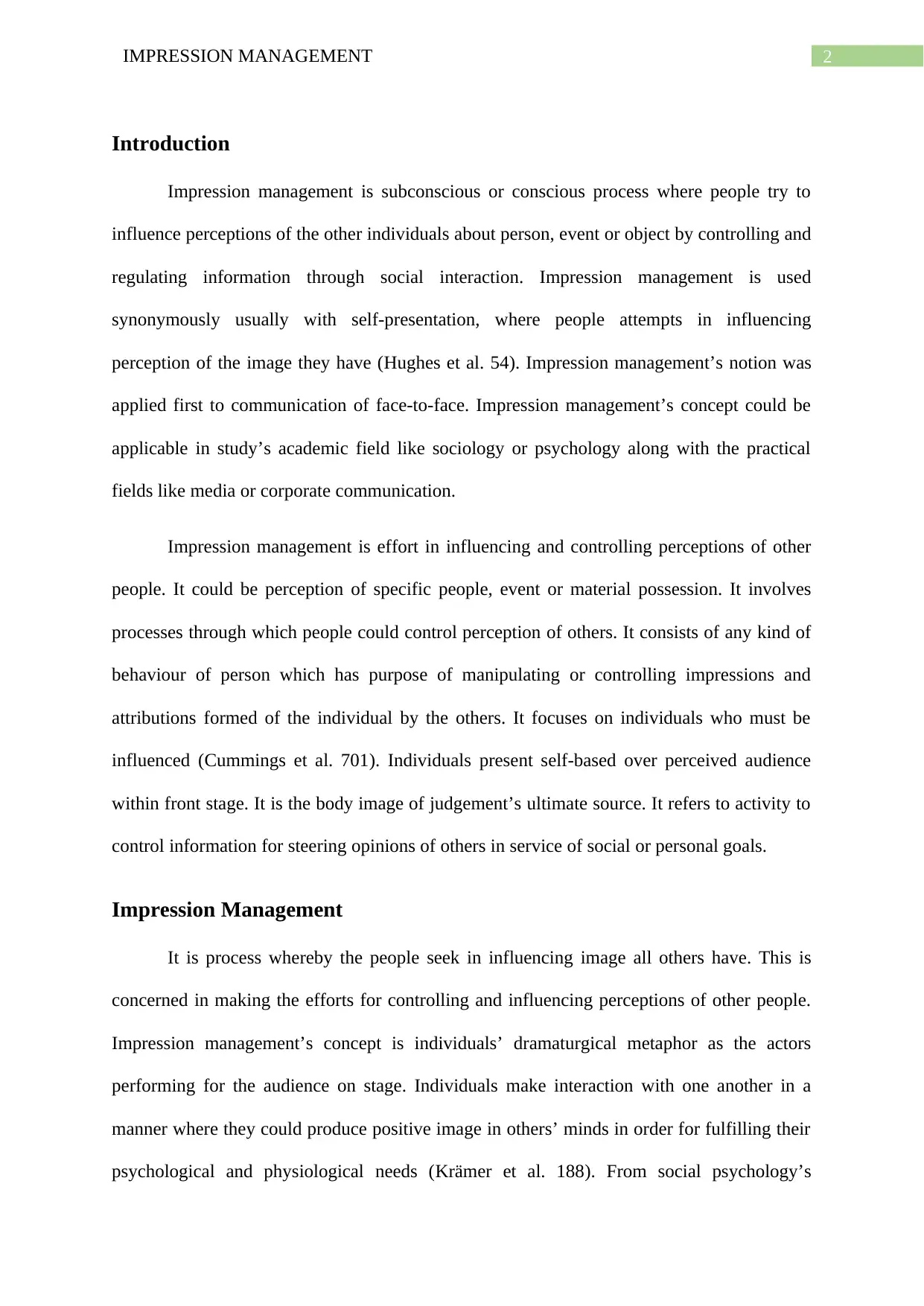
2IMPRESSION MANAGEMENT
Introduction
Impression management is subconscious or conscious process where people try to
influence perceptions of the other individuals about person, event or object by controlling and
regulating information through social interaction. Impression management is used
synonymously usually with self-presentation, where people attempts in influencing
perception of the image they have (Hughes et al. 54). Impression management’s notion was
applied first to communication of face-to-face. Impression management’s concept could be
applicable in study’s academic field like sociology or psychology along with the practical
fields like media or corporate communication.
Impression management is effort in influencing and controlling perceptions of other
people. It could be perception of specific people, event or material possession. It involves
processes through which people could control perception of others. It consists of any kind of
behaviour of person which has purpose of manipulating or controlling impressions and
attributions formed of the individual by the others. It focuses on individuals who must be
influenced (Cummings et al. 701). Individuals present self-based over perceived audience
within front stage. It is the body image of judgement’s ultimate source. It refers to activity to
control information for steering opinions of others in service of social or personal goals.
Impression Management
It is process whereby the people seek in influencing image all others have. This is
concerned in making the efforts for controlling and influencing perceptions of other people.
Impression management’s concept is individuals’ dramaturgical metaphor as the actors
performing for the audience on stage. Individuals make interaction with one another in a
manner where they could produce positive image in others’ minds in order for fulfilling their
psychological and physiological needs (Krämer et al. 188). From social psychology’s
Introduction
Impression management is subconscious or conscious process where people try to
influence perceptions of the other individuals about person, event or object by controlling and
regulating information through social interaction. Impression management is used
synonymously usually with self-presentation, where people attempts in influencing
perception of the image they have (Hughes et al. 54). Impression management’s notion was
applied first to communication of face-to-face. Impression management’s concept could be
applicable in study’s academic field like sociology or psychology along with the practical
fields like media or corporate communication.
Impression management is effort in influencing and controlling perceptions of other
people. It could be perception of specific people, event or material possession. It involves
processes through which people could control perception of others. It consists of any kind of
behaviour of person which has purpose of manipulating or controlling impressions and
attributions formed of the individual by the others. It focuses on individuals who must be
influenced (Cummings et al. 701). Individuals present self-based over perceived audience
within front stage. It is the body image of judgement’s ultimate source. It refers to activity to
control information for steering opinions of others in service of social or personal goals.
Impression Management
It is process whereby the people seek in influencing image all others have. This is
concerned in making the efforts for controlling and influencing perceptions of other people.
Impression management’s concept is individuals’ dramaturgical metaphor as the actors
performing for the audience on stage. Individuals make interaction with one another in a
manner where they could produce positive image in others’ minds in order for fulfilling their
psychological and physiological needs (Krämer et al. 188). From social psychology’s
⊘ This is a preview!⊘
Do you want full access?
Subscribe today to unlock all pages.

Trusted by 1+ million students worldwide
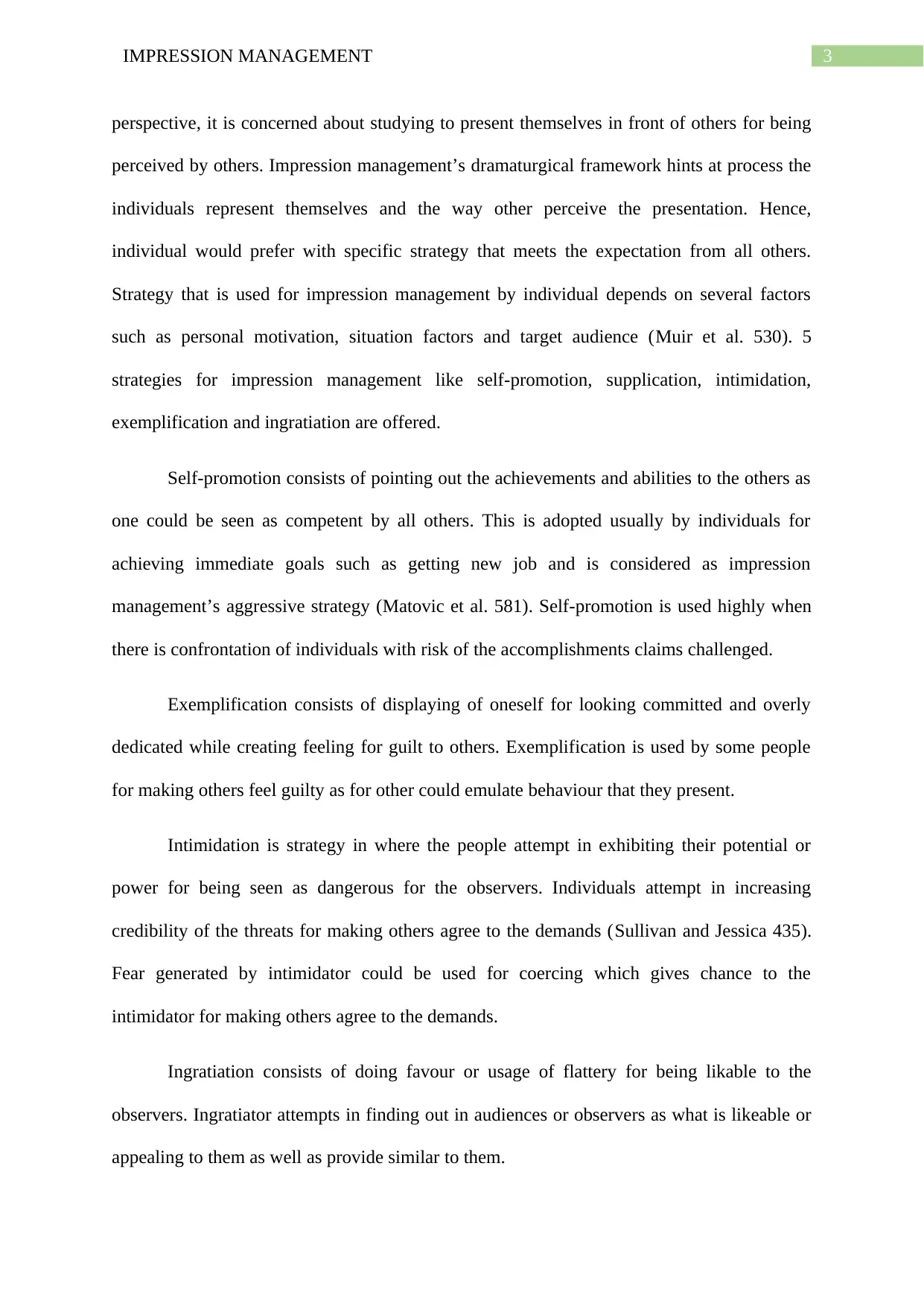
3IMPRESSION MANAGEMENT
perspective, it is concerned about studying to present themselves in front of others for being
perceived by others. Impression management’s dramaturgical framework hints at process the
individuals represent themselves and the way other perceive the presentation. Hence,
individual would prefer with specific strategy that meets the expectation from all others.
Strategy that is used for impression management by individual depends on several factors
such as personal motivation, situation factors and target audience (Muir et al. 530). 5
strategies for impression management like self-promotion, supplication, intimidation,
exemplification and ingratiation are offered.
Self-promotion consists of pointing out the achievements and abilities to the others as
one could be seen as competent by all others. This is adopted usually by individuals for
achieving immediate goals such as getting new job and is considered as impression
management’s aggressive strategy (Matovic et al. 581). Self-promotion is used highly when
there is confrontation of individuals with risk of the accomplishments claims challenged.
Exemplification consists of displaying of oneself for looking committed and overly
dedicated while creating feeling for guilt to others. Exemplification is used by some people
for making others feel guilty as for other could emulate behaviour that they present.
Intimidation is strategy in where the people attempt in exhibiting their potential or
power for being seen as dangerous for the observers. Individuals attempt in increasing
credibility of the threats for making others agree to the demands (Sullivan and Jessica 435).
Fear generated by intimidator could be used for coercing which gives chance to the
intimidator for making others agree to the demands.
Ingratiation consists of doing favour or usage of flattery for being likable to the
observers. Ingratiator attempts in finding out in audiences or observers as what is likeable or
appealing to them as well as provide similar to them.
perspective, it is concerned about studying to present themselves in front of others for being
perceived by others. Impression management’s dramaturgical framework hints at process the
individuals represent themselves and the way other perceive the presentation. Hence,
individual would prefer with specific strategy that meets the expectation from all others.
Strategy that is used for impression management by individual depends on several factors
such as personal motivation, situation factors and target audience (Muir et al. 530). 5
strategies for impression management like self-promotion, supplication, intimidation,
exemplification and ingratiation are offered.
Self-promotion consists of pointing out the achievements and abilities to the others as
one could be seen as competent by all others. This is adopted usually by individuals for
achieving immediate goals such as getting new job and is considered as impression
management’s aggressive strategy (Matovic et al. 581). Self-promotion is used highly when
there is confrontation of individuals with risk of the accomplishments claims challenged.
Exemplification consists of displaying of oneself for looking committed and overly
dedicated while creating feeling for guilt to others. Exemplification is used by some people
for making others feel guilty as for other could emulate behaviour that they present.
Intimidation is strategy in where the people attempt in exhibiting their potential or
power for being seen as dangerous for the observers. Individuals attempt in increasing
credibility of the threats for making others agree to the demands (Sullivan and Jessica 435).
Fear generated by intimidator could be used for coercing which gives chance to the
intimidator for making others agree to the demands.
Ingratiation consists of doing favour or usage of flattery for being likable to the
observers. Ingratiator attempts in finding out in audiences or observers as what is likeable or
appealing to them as well as provide similar to them.
Paraphrase This Document
Need a fresh take? Get an instant paraphrase of this document with our AI Paraphraser
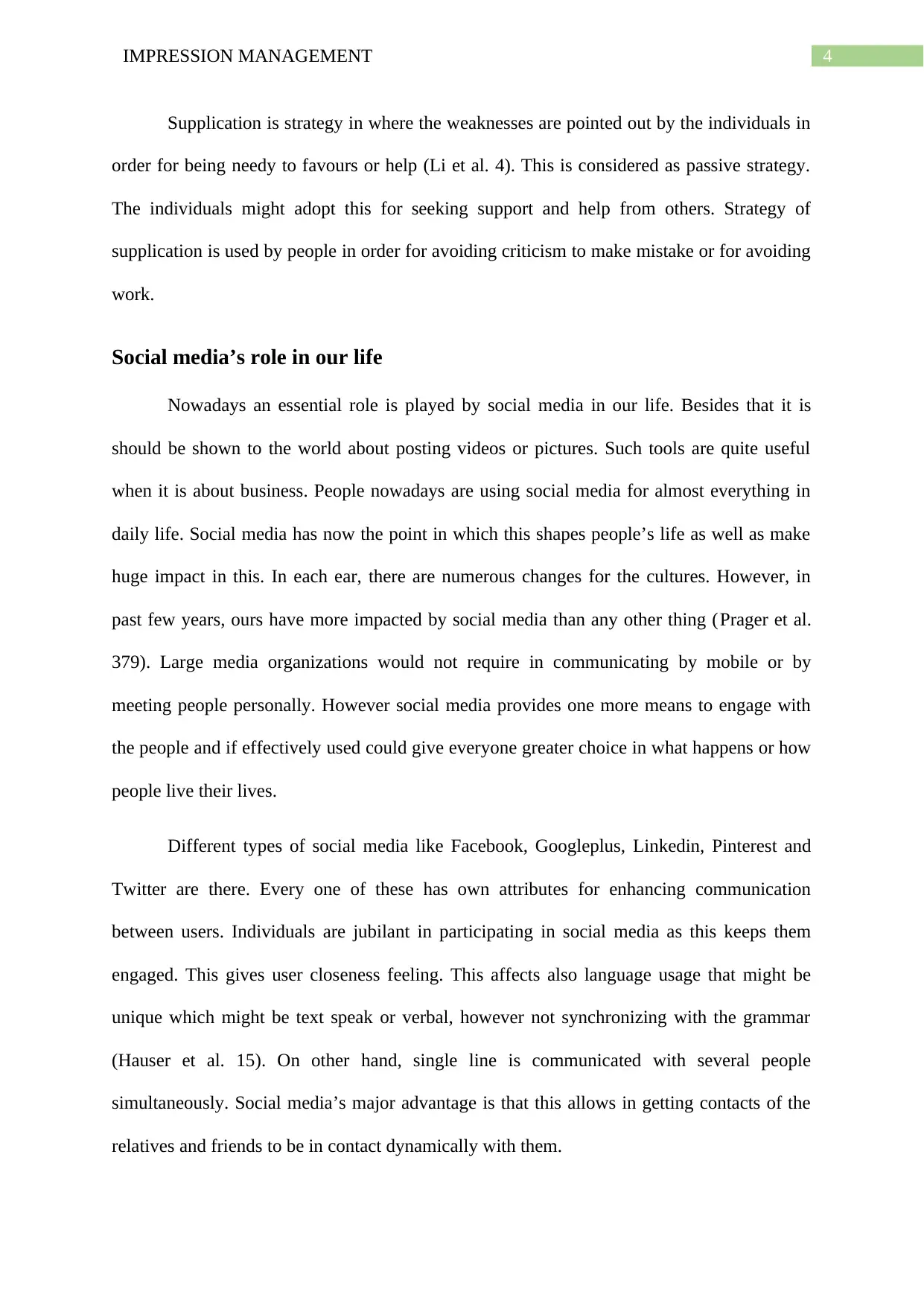
4IMPRESSION MANAGEMENT
Supplication is strategy in where the weaknesses are pointed out by the individuals in
order for being needy to favours or help (Li et al. 4). This is considered as passive strategy.
The individuals might adopt this for seeking support and help from others. Strategy of
supplication is used by people in order for avoiding criticism to make mistake or for avoiding
work.
Social media’s role in our life
Nowadays an essential role is played by social media in our life. Besides that it is
should be shown to the world about posting videos or pictures. Such tools are quite useful
when it is about business. People nowadays are using social media for almost everything in
daily life. Social media has now the point in which this shapes people’s life as well as make
huge impact in this. In each ear, there are numerous changes for the cultures. However, in
past few years, ours have more impacted by social media than any other thing (Prager et al.
379). Large media organizations would not require in communicating by mobile or by
meeting people personally. However social media provides one more means to engage with
the people and if effectively used could give everyone greater choice in what happens or how
people live their lives.
Different types of social media like Facebook, Googleplus, Linkedin, Pinterest and
Twitter are there. Every one of these has own attributes for enhancing communication
between users. Individuals are jubilant in participating in social media as this keeps them
engaged. This gives user closeness feeling. This affects also language usage that might be
unique which might be text speak or verbal, however not synchronizing with the grammar
(Hauser et al. 15). On other hand, single line is communicated with several people
simultaneously. Social media’s major advantage is that this allows in getting contacts of the
relatives and friends to be in contact dynamically with them.
Supplication is strategy in where the weaknesses are pointed out by the individuals in
order for being needy to favours or help (Li et al. 4). This is considered as passive strategy.
The individuals might adopt this for seeking support and help from others. Strategy of
supplication is used by people in order for avoiding criticism to make mistake or for avoiding
work.
Social media’s role in our life
Nowadays an essential role is played by social media in our life. Besides that it is
should be shown to the world about posting videos or pictures. Such tools are quite useful
when it is about business. People nowadays are using social media for almost everything in
daily life. Social media has now the point in which this shapes people’s life as well as make
huge impact in this. In each ear, there are numerous changes for the cultures. However, in
past few years, ours have more impacted by social media than any other thing (Prager et al.
379). Large media organizations would not require in communicating by mobile or by
meeting people personally. However social media provides one more means to engage with
the people and if effectively used could give everyone greater choice in what happens or how
people live their lives.
Different types of social media like Facebook, Googleplus, Linkedin, Pinterest and
Twitter are there. Every one of these has own attributes for enhancing communication
between users. Individuals are jubilant in participating in social media as this keeps them
engaged. This gives user closeness feeling. This affects also language usage that might be
unique which might be text speak or verbal, however not synchronizing with the grammar
(Hauser et al. 15). On other hand, single line is communicated with several people
simultaneously. Social media’s major advantage is that this allows in getting contacts of the
relatives and friends to be in contact dynamically with them.
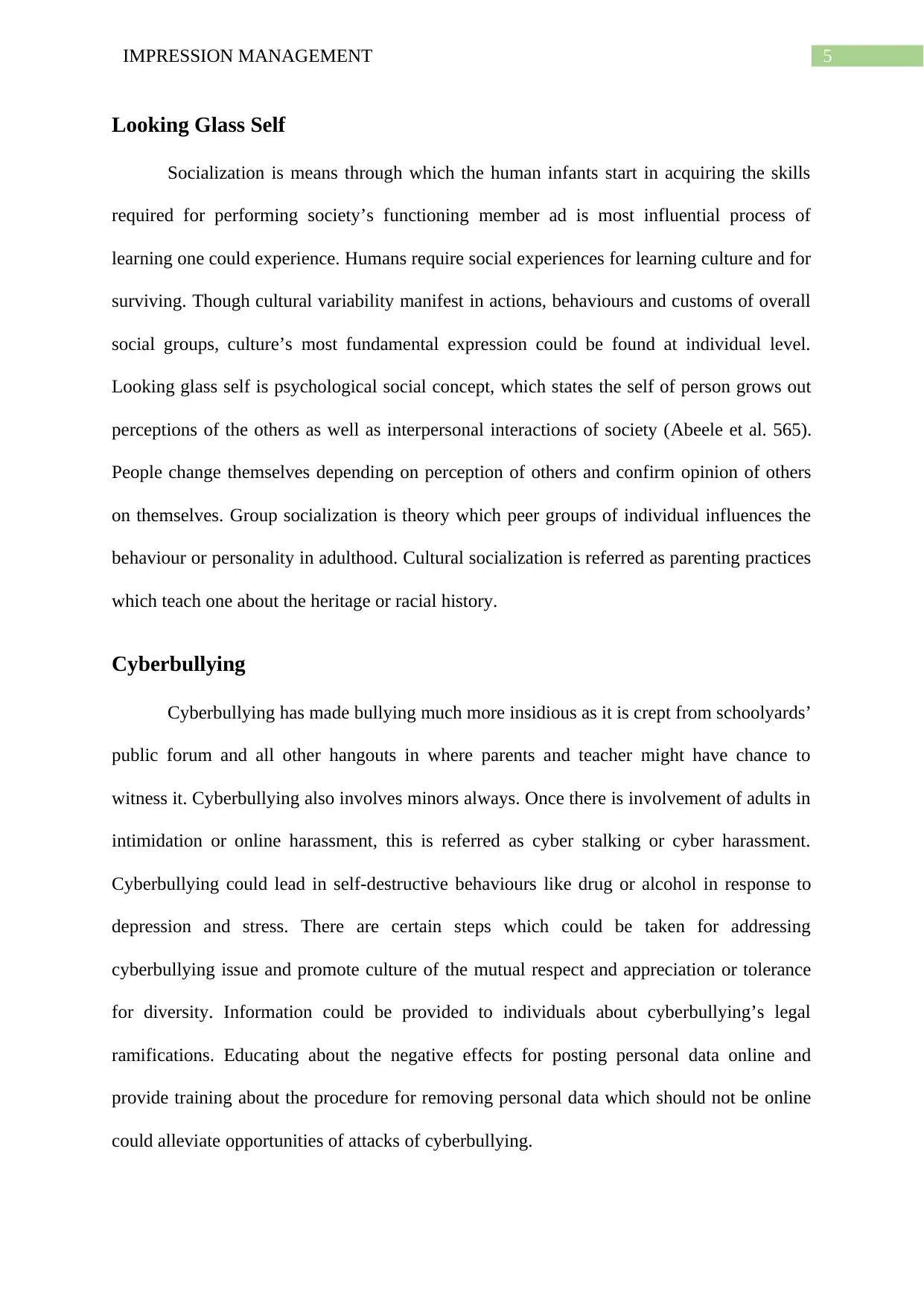
5IMPRESSION MANAGEMENT
Looking Glass Self
Socialization is means through which the human infants start in acquiring the skills
required for performing society’s functioning member ad is most influential process of
learning one could experience. Humans require social experiences for learning culture and for
surviving. Though cultural variability manifest in actions, behaviours and customs of overall
social groups, culture’s most fundamental expression could be found at individual level.
Looking glass self is psychological social concept, which states the self of person grows out
perceptions of the others as well as interpersonal interactions of society (Abeele et al. 565).
People change themselves depending on perception of others and confirm opinion of others
on themselves. Group socialization is theory which peer groups of individual influences the
behaviour or personality in adulthood. Cultural socialization is referred as parenting practices
which teach one about the heritage or racial history.
Cyberbullying
Cyberbullying has made bullying much more insidious as it is crept from schoolyards’
public forum and all other hangouts in where parents and teacher might have chance to
witness it. Cyberbullying also involves minors always. Once there is involvement of adults in
intimidation or online harassment, this is referred as cyber stalking or cyber harassment.
Cyberbullying could lead in self-destructive behaviours like drug or alcohol in response to
depression and stress. There are certain steps which could be taken for addressing
cyberbullying issue and promote culture of the mutual respect and appreciation or tolerance
for diversity. Information could be provided to individuals about cyberbullying’s legal
ramifications. Educating about the negative effects for posting personal data online and
provide training about the procedure for removing personal data which should not be online
could alleviate opportunities of attacks of cyberbullying.
Looking Glass Self
Socialization is means through which the human infants start in acquiring the skills
required for performing society’s functioning member ad is most influential process of
learning one could experience. Humans require social experiences for learning culture and for
surviving. Though cultural variability manifest in actions, behaviours and customs of overall
social groups, culture’s most fundamental expression could be found at individual level.
Looking glass self is psychological social concept, which states the self of person grows out
perceptions of the others as well as interpersonal interactions of society (Abeele et al. 565).
People change themselves depending on perception of others and confirm opinion of others
on themselves. Group socialization is theory which peer groups of individual influences the
behaviour or personality in adulthood. Cultural socialization is referred as parenting practices
which teach one about the heritage or racial history.
Cyberbullying
Cyberbullying has made bullying much more insidious as it is crept from schoolyards’
public forum and all other hangouts in where parents and teacher might have chance to
witness it. Cyberbullying also involves minors always. Once there is involvement of adults in
intimidation or online harassment, this is referred as cyber stalking or cyber harassment.
Cyberbullying could lead in self-destructive behaviours like drug or alcohol in response to
depression and stress. There are certain steps which could be taken for addressing
cyberbullying issue and promote culture of the mutual respect and appreciation or tolerance
for diversity. Information could be provided to individuals about cyberbullying’s legal
ramifications. Educating about the negative effects for posting personal data online and
provide training about the procedure for removing personal data which should not be online
could alleviate opportunities of attacks of cyberbullying.
⊘ This is a preview!⊘
Do you want full access?
Subscribe today to unlock all pages.

Trusted by 1+ million students worldwide
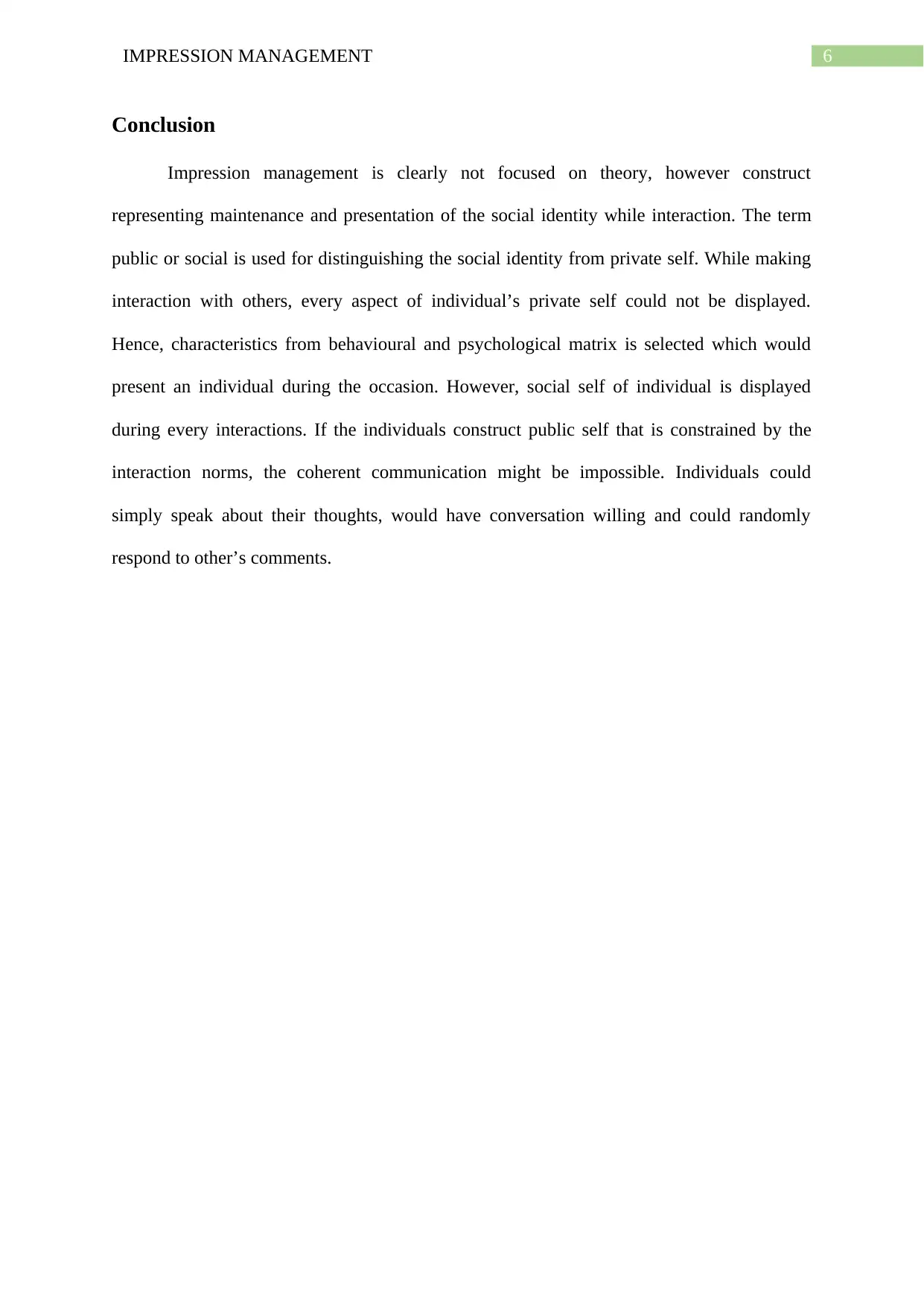
6IMPRESSION MANAGEMENT
Conclusion
Impression management is clearly not focused on theory, however construct
representing maintenance and presentation of the social identity while interaction. The term
public or social is used for distinguishing the social identity from private self. While making
interaction with others, every aspect of individual’s private self could not be displayed.
Hence, characteristics from behavioural and psychological matrix is selected which would
present an individual during the occasion. However, social self of individual is displayed
during every interactions. If the individuals construct public self that is constrained by the
interaction norms, the coherent communication might be impossible. Individuals could
simply speak about their thoughts, would have conversation willing and could randomly
respond to other’s comments.
Conclusion
Impression management is clearly not focused on theory, however construct
representing maintenance and presentation of the social identity while interaction. The term
public or social is used for distinguishing the social identity from private self. While making
interaction with others, every aspect of individual’s private self could not be displayed.
Hence, characteristics from behavioural and psychological matrix is selected which would
present an individual during the occasion. However, social self of individual is displayed
during every interactions. If the individuals construct public self that is constrained by the
interaction norms, the coherent communication might be impossible. Individuals could
simply speak about their thoughts, would have conversation willing and could randomly
respond to other’s comments.
Paraphrase This Document
Need a fresh take? Get an instant paraphrase of this document with our AI Paraphraser
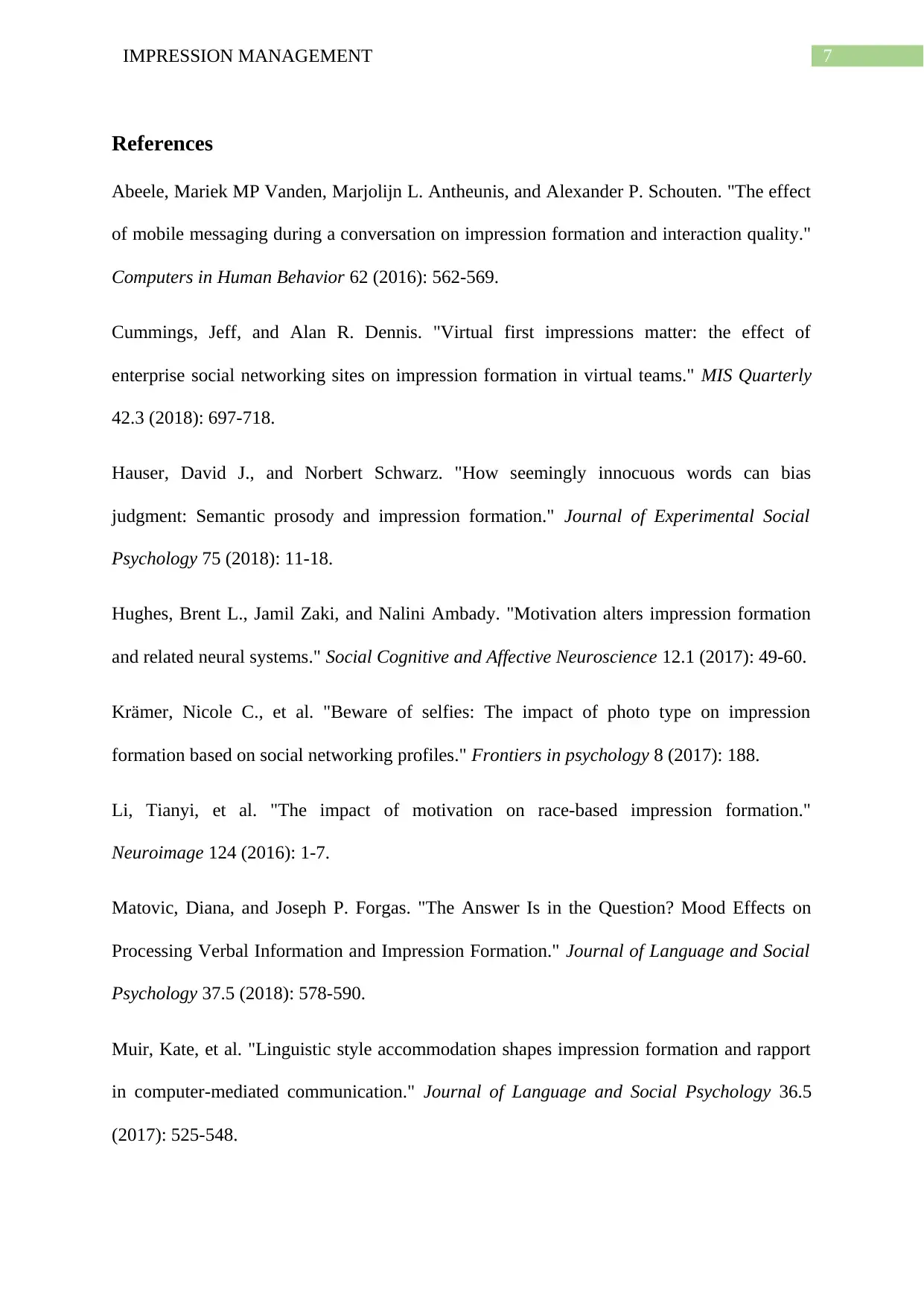
7IMPRESSION MANAGEMENT
References
Abeele, Mariek MP Vanden, Marjolijn L. Antheunis, and Alexander P. Schouten. "The effect
of mobile messaging during a conversation on impression formation and interaction quality."
Computers in Human Behavior 62 (2016): 562-569.
Cummings, Jeff, and Alan R. Dennis. "Virtual first impressions matter: the effect of
enterprise social networking sites on impression formation in virtual teams." MIS Quarterly
42.3 (2018): 697-718.
Hauser, David J., and Norbert Schwarz. "How seemingly innocuous words can bias
judgment: Semantic prosody and impression formation." Journal of Experimental Social
Psychology 75 (2018): 11-18.
Hughes, Brent L., Jamil Zaki, and Nalini Ambady. "Motivation alters impression formation
and related neural systems." Social Cognitive and Affective Neuroscience 12.1 (2017): 49-60.
Krämer, Nicole C., et al. "Beware of selfies: The impact of photo type on impression
formation based on social networking profiles." Frontiers in psychology 8 (2017): 188.
Li, Tianyi, et al. "The impact of motivation on race-based impression formation."
Neuroimage 124 (2016): 1-7.
Matovic, Diana, and Joseph P. Forgas. "The Answer Is in the Question? Mood Effects on
Processing Verbal Information and Impression Formation." Journal of Language and Social
Psychology 37.5 (2018): 578-590.
Muir, Kate, et al. "Linguistic style accommodation shapes impression formation and rapport
in computer-mediated communication." Journal of Language and Social Psychology 36.5
(2017): 525-548.
References
Abeele, Mariek MP Vanden, Marjolijn L. Antheunis, and Alexander P. Schouten. "The effect
of mobile messaging during a conversation on impression formation and interaction quality."
Computers in Human Behavior 62 (2016): 562-569.
Cummings, Jeff, and Alan R. Dennis. "Virtual first impressions matter: the effect of
enterprise social networking sites on impression formation in virtual teams." MIS Quarterly
42.3 (2018): 697-718.
Hauser, David J., and Norbert Schwarz. "How seemingly innocuous words can bias
judgment: Semantic prosody and impression formation." Journal of Experimental Social
Psychology 75 (2018): 11-18.
Hughes, Brent L., Jamil Zaki, and Nalini Ambady. "Motivation alters impression formation
and related neural systems." Social Cognitive and Affective Neuroscience 12.1 (2017): 49-60.
Krämer, Nicole C., et al. "Beware of selfies: The impact of photo type on impression
formation based on social networking profiles." Frontiers in psychology 8 (2017): 188.
Li, Tianyi, et al. "The impact of motivation on race-based impression formation."
Neuroimage 124 (2016): 1-7.
Matovic, Diana, and Joseph P. Forgas. "The Answer Is in the Question? Mood Effects on
Processing Verbal Information and Impression Formation." Journal of Language and Social
Psychology 37.5 (2018): 578-590.
Muir, Kate, et al. "Linguistic style accommodation shapes impression formation and rapport
in computer-mediated communication." Journal of Language and Social Psychology 36.5
(2017): 525-548.
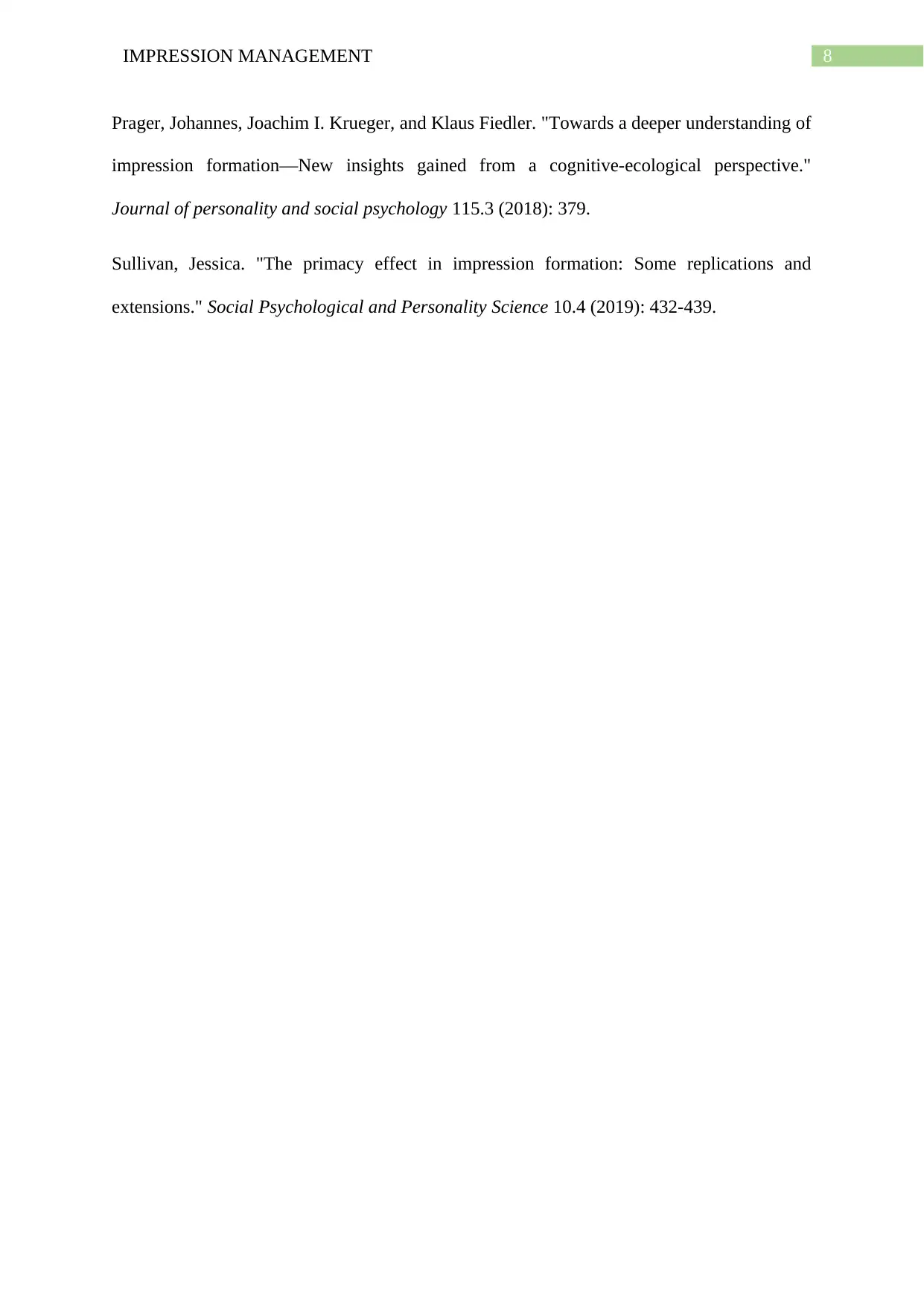
8IMPRESSION MANAGEMENT
Prager, Johannes, Joachim I. Krueger, and Klaus Fiedler. "Towards a deeper understanding of
impression formation—New insights gained from a cognitive-ecological perspective."
Journal of personality and social psychology 115.3 (2018): 379.
Sullivan, Jessica. "The primacy effect in impression formation: Some replications and
extensions." Social Psychological and Personality Science 10.4 (2019): 432-439.
Prager, Johannes, Joachim I. Krueger, and Klaus Fiedler. "Towards a deeper understanding of
impression formation—New insights gained from a cognitive-ecological perspective."
Journal of personality and social psychology 115.3 (2018): 379.
Sullivan, Jessica. "The primacy effect in impression formation: Some replications and
extensions." Social Psychological and Personality Science 10.4 (2019): 432-439.
⊘ This is a preview!⊘
Do you want full access?
Subscribe today to unlock all pages.

Trusted by 1+ million students worldwide
1 out of 9
Related Documents
Your All-in-One AI-Powered Toolkit for Academic Success.
+13062052269
info@desklib.com
Available 24*7 on WhatsApp / Email
![[object Object]](/_next/static/media/star-bottom.7253800d.svg)
Unlock your academic potential
Copyright © 2020–2025 A2Z Services. All Rights Reserved. Developed and managed by ZUCOL.





